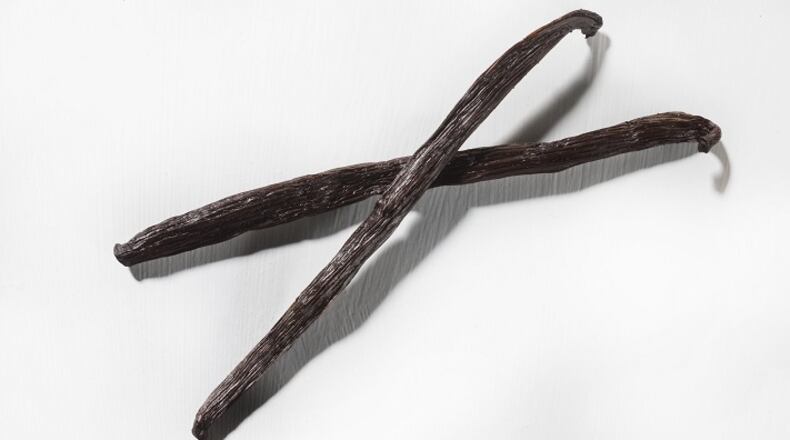I recently received a gift of vanilla-scented perfume. A splash on my wrist evoked childhood memories of plain vanilla frozen custard and a time of simplicity.
But the process of making vanilla extract is neither plain nor simple. Vanilla begins as a long, thin pod on a tropical climbing orchid, the fruit of a flower that blooms for only one day. Hand pollination must occur on that day, or the pod will not form.
The whole cycle of ripening, harvesting by hand, drying, curing, and processing takes months, which accounts for vanilla’s expensive price. It takes approximately a pound of cured vanilla beans to make a gallon of pure vanilla extract. Vanilla extract is made by soaking the pods in alcohol and water. Some brands may also contain added sugar.
Vanilla is available in other forms, including powder and paste (available online). Vanilla beans originated in Mexico and Central America and are cultivated in Madagascar, Tahiti (where vanilla used in perfume is made), and Indonesia. The differences between them are slight, especially when combined with other flavors in baked goods.
Many kinds of vanilla orchids are grown in South Florida as a backyard crop. When purchasing beans look for ones that are plump and pliable and have a strong aroma. Store the beans upright in a jar with a half-inch of rum or vodka to keep them moist.
Homemade vanilla extract can be made by splitting eight beans lengthwise to expose the seeds, keeping the ends intact and soaking in two cups of vodka or rum in a tall jar. Seal the jar tightly and let stand in a cool dark place at least six weeks, gently shaking once a week.
To remove the seeds from the bean, use the tip of a small knife to cut the bean in half lengthwise, and use the knife blade to scrape out the seeds. You can then add the seeds per your recipe’s directions. One vanilla bean is about equal to 3 teaspoons vanilla extract.
The flavorful pods shouldn’t be wasted. After rinsing and drying, add them to a container of granulated sugar for vanilla sugar. Bakers recognize that adding vanilla to pastries and desserts acts as a flavor enhancer, but vanilla also brings out savory flavors. Vanilla complements the flavors in low-and-slow braises like spicy pork carnitas and short ribs and amplifies the herbs and spices in tomato sauce; vanilla rounds out the sharp elements of a vinaigrette, salsa, or chutney.
For vanilla-mango salsa, dice mango and combine with spicy jalapeño, red tomatoes, red onions, lime juice, and a splash of vanilla. The vanilla enhances the natural sweetness of the mango. Seafood like lobster, fish, or scallops are delicious served with a brown butter with a little scraped vanilla bean in it. By the way, vanilla is still the country’s favorite ice cream flavor.
———
VANILLA VEGETABLE SALAD
Adapted from “Around My French Table” by Dorie Greenspan, Houghton Mifflin Harcourt ($40).
This beautiful salad can be served as a first course or as an accompaniment to grilled meats. The 2016 Michele Chiarlo Le Marne Gavi DOCG ($19.95) is full of aromatic citrus and mineral characteristics with lime and green apple flavors on the palate, making it a perfect choice for this salad. The crisp acidity in the wine balances the sweetness of the vanilla in the dressing.
The vanilla vinaigrette can be made up to a few hours ahead, but it’s best to toss and dress this salad at the last minute.
2 young sweet carrots, trimmed and scrubbed or peeled
1 young yellow summer squash, trimmed
1 1/2-2 tablespoons extra-virgin olive oil
About 1 tablespoon fresh lemon juice
About 1/4 teaspoon pure vanilla extract
Salt, preferably fleur de sel, and freshly ground pepper
4 handfuls of mixed salad greens or mesclun
Cut the vegetables into ribbons with a vegetable peeler or a mandolin slicer. Start slicing each carrot on one side, continuing until you reach the core.
Combine 1 1/2 tablespoons olive oil, 1 tablespoon lemon juice, 1/4 teaspoon vanilla extract, and a little salt and pepper in a jar and shake; or whisk together in a bowl. Taste for balance, adjusting the amounts of oil, lemon, and vanilla if you think the vinaigrette needs it. What you’re after is a light, lemony dressing, one in which the flavor of vanilla is present but not very strong.
To serve the salad, put the greens into a bowl, season with salt and pepper and toss with a little of the vinaigrette. Divide the greens among four plates. Put the carrot and squash ribbons in the bowl, season, and dress with vinaigrette to taste, then arrange them over the greens. If you’d like, give each plate a little toss before serving. Alternatively, you can make a single salad in a large bowl and toss and serve it at the table.
Serves 4.
About the Author
The Latest
Featured


